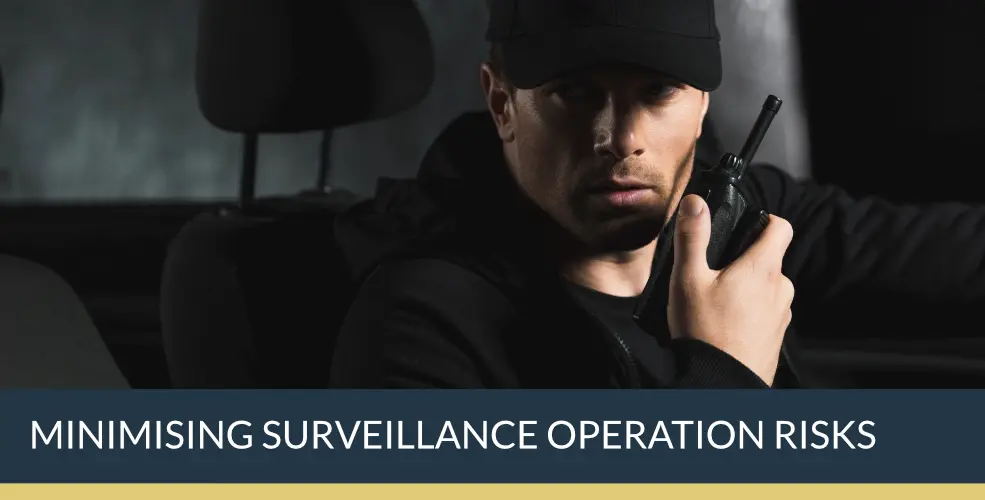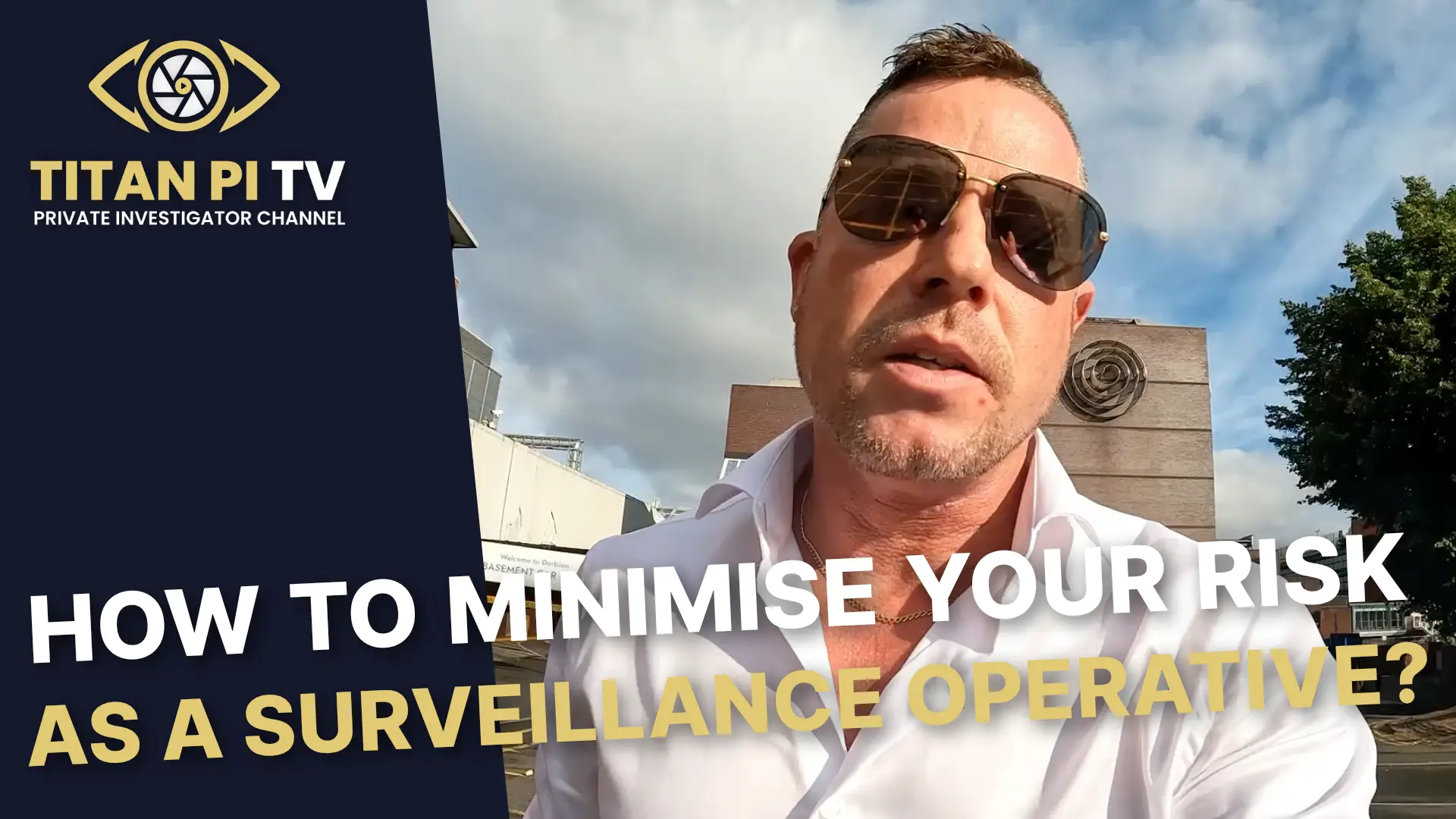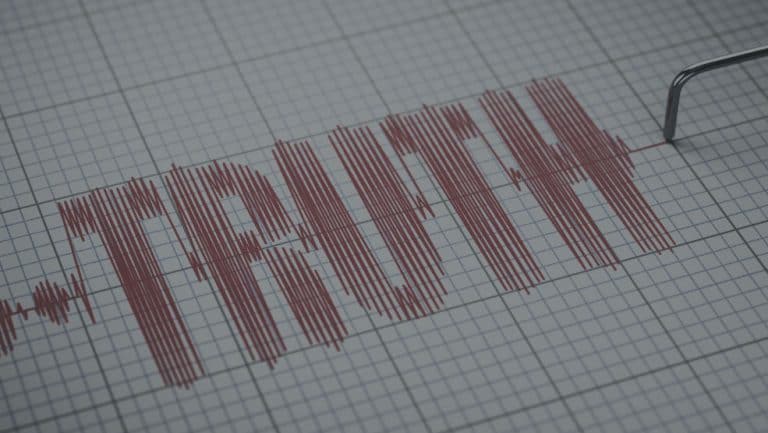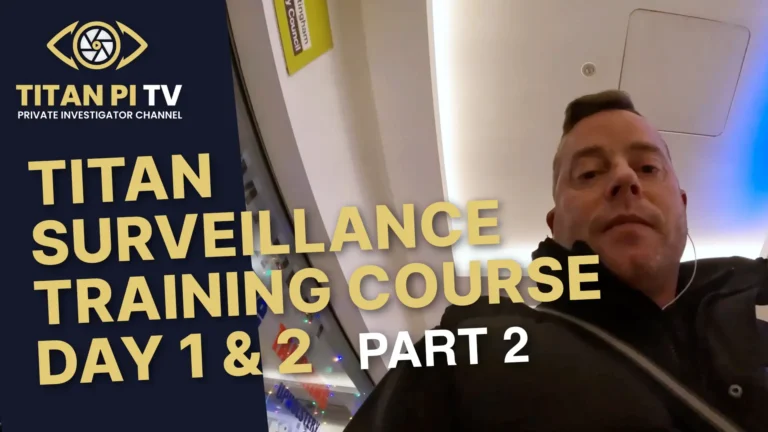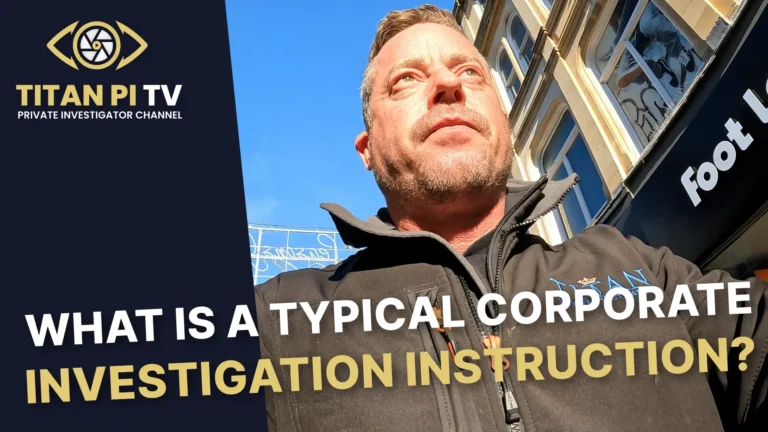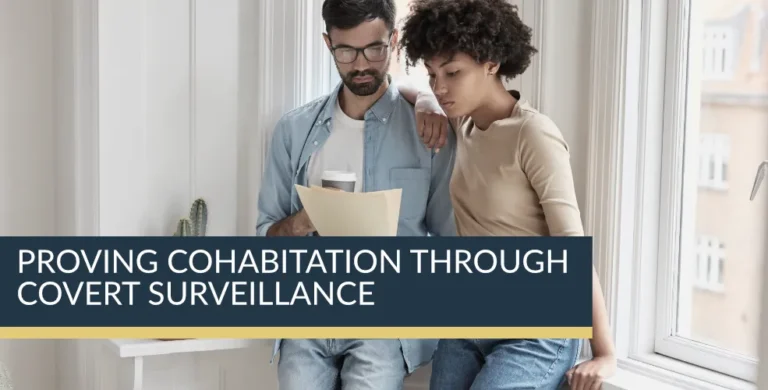Minimising Surveillance Operation Risks for Surveillance Operatives
An Operational Risks Guide for Surveillance Operatives
The life of a surveillance operative is inherently high-risk, demanding constant vigilance and strategic thinking. Beyond the technical aspects of covert observation, understanding and mitigating potential dangers is paramount to a successful and safe deployment. This article delves into the critical elements that surveillance professionals must master to minimise their exposure to compromise and danger, ensuring operational integrity and personal well-being.
Mastering Cover Stories: Your First Line of Defence
A well-crafted cover story is not merely a response to a query; it is a foundational element of surveillance operation risks mitigation. It provides a plausible and consistent explanation for your presence in any given situation, serving to deflect suspicion from the public, third parties, or even the subject of surveillance. Without a believable cover, even the most experienced operative can find themselves compromised.
A believable narrative begins long before you are challenged. You need a solid reason for being where you are, and you need to carry that reason in your body language, clothing, and equipment. If you are potentially in view of the subject, your presence should appear entirely unremarkable. That includes the small things: a parking ticket on your dashboard if you are in a pay-and-display zone, a coffee cup that explains why you have been stationary, or a shopping bag that justifies your loitering near a retail parade.
Crafting an appropriate cover story requires alignment between persona and environment. If you are dressed smartly, a business-related explanation is credible; if you are in casual clothing, a dog-walking or delivery-related reason is more convincing. Consider the script you will use if engaged and practise it aloud until it feels natural. Include details that can withstand light probing—street names, company names that actually exist nearby, and times that align with reality. Always have a secondary plan ready if your first explanation is not landing. If your cover is queried and you sense escalation, disengage gracefully rather than doubling down.
Maintaining covertness with your story means letting your behaviour and props do most of the talking. People instinctively trust consistency; if what you are doing, what you are wearing, and what you are saying all align, most passers-by will not look twice. Conversely, incongruence invites scrutiny. Avoid overexplaining. Keep your answers succinct and confident, and once the interaction ends, execute a calm relocation so you are not observed lingering.
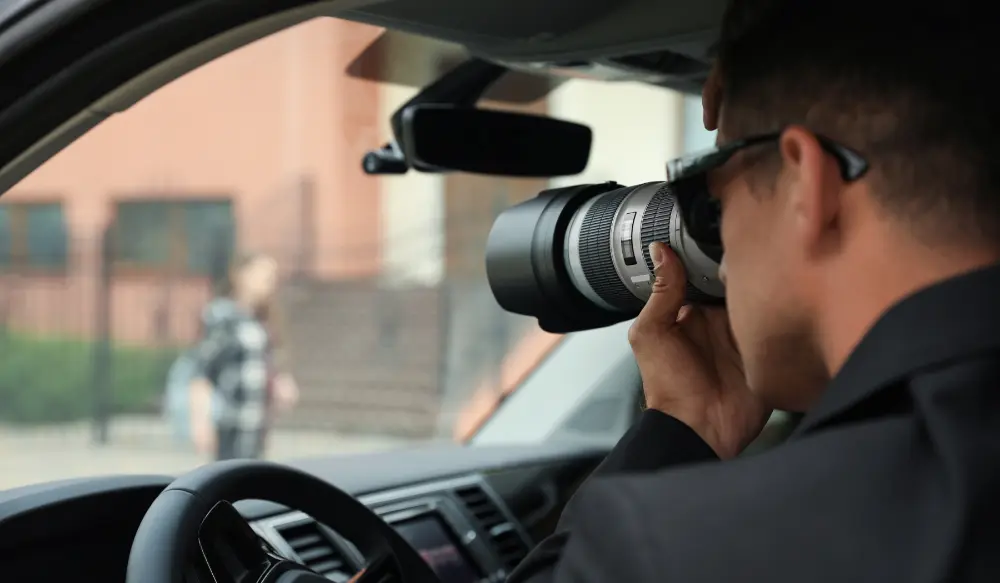
The Art of Remaining Covert: Blending In Seamlessly
Beyond the spoken word, true covertness lies in your actions, appearance, and overall presence. Standing out is the quickest route to detection. Understanding how to blend into your surroundings, utilise appropriate props, and behave naturally are crucial skills for any surveillance operative.
Assessing your covertness begins with a candid appraisal of your fit within the environment. On foot in a busy high street, your pace, gaze, and posture should mirror those around you. In a vehicle, your movements—mirror checks, occasional repositioning, and casual interactions with your phone or sat-nav—should be indistinguishable from any other motorist waiting for someone. In pedestrianised spaces, sitting inert in a car draws attention; reposition to a credible vantage point on foot and become part of the street’s natural flow.
Props and appearance can extend your operational endurance. A high-visibility vest can transform you into perceived infrastructure, granting you permission to be present around construction sites or roadside verges. A branded lanyard (non-deceptive and generic) can make you look like a contractor or surveyor. An umbrella on a sunny day looks odd; a book and headphones in a park look normal. Be thoughtful about what you carry and how it reads at a glance. A small rucksack can discreetly store optics, a charger, and contingency items without advertising that you are equipped.
Behavioural indicators of compromise often creep in under pressure. Over-fixating on the subject, staying too static for the setting, or repeatedly adjusting position in a way that does not match environmental cues are common tells. Build in self-audits: every ten minutes, ask yourself whether you look like everyone else and whether your placement still makes sense. If the answer is no, reset your posture, change your prop, or move.
Prioritising Personal Safety: Proactive Threat Management
Personal safety is non-negotiable in surveillance. This involves not only recognising immediate threats but also taking proactive measures to avoid dangerous situations. A compromised operative cannot achieve their objectives, and an injured operative cannot continue their work.
Environmental awareness begins with reconnaissance. Before a deployment, evaluate parking options, lighting conditions, footfall patterns, and potential choke points. Map safe exit routes, identify places to discreetly regroup, and note any hotspots such as pubs on match day, cash-heavy premises, or areas with a history of disorder. On arrival, keep your head on a swivel without appearing anxious. In a car, doors should be locked, windows adjusted to allow airflow without enabling easy access, and your seat positioned so you can drive off without readjustments.
Vehicle safety and security are more than anti-theft considerations; they are about preventing you from becoming a static target. Avoid boxing yourself in and keep your vehicle pointing towards a viable exit. If challenged at your window, do not open the door; crack the window minimally if needed to deliver your cover line, then disengage. Park with intent. Avoid directly outside the subject’s property unless there is a credible reason and blend amongst other vehicles where possible. If there is a risk of the subject conducting their own counter-surveillance, vary your positions and timings.
Managing confrontation relies on professional calm. If approached by a member of the public, adopt a friendly, non-defensive tone and utilise your cover story. If the police approach, be polite and cooperative; in the UK you may be asked to account for your presence. Depending on the nature of the instruction and your client’s authorisation, be prepared to verify your identity off the public thoroughfare and, if necessary, contact your operations manager. Always aim to de-escalate. Your safety is more important than the footage you might capture in the next five minutes.
First aid preparedness is part of your surveillance operation risks plan. A compact kit in your vehicle and on your person should include gloves, plasters, a tourniquet, a haemostatic dressing, and a thermal blanket. Train regularly in basic life support and catastrophic bleeding control. In stressful environments, knowing you have the means and skills to deal with an emergency reduces cognitive load and improves decision-making.
The Principles of Loss vs Gain: Strategic Decision-Making
Every operational decision carries potential consequences. The principle of loss versus gain encourages operatives to weigh the potential benefits of a particular action against the risks of exposure or compromise. This involves understanding client objectives and making informed choices about when to push for closer observation and when to maintain distance.
Evaluating the risks of close proximity is a dynamic calculation. Moving into a small shop behind the subject might produce compelling imagery, but if the shop is quiet and the subject is hyper-aware, the risk increases significantly. Conversely, allowing the subject to walk out of view for thirty seconds to maintain cover might preserve the operation for hours. Knowing when to accept a temporary loss to secure a larger gain is the mark of a mature operator.
Aligning actions with client objectives is critical. If the brief hinges on evidential clarity—such as capturing a hand-to-hand exchange—there may be justification for taking a carefully managed risk. Where the objective is pattern-of-life or association mapping, preservation of the long game takes precedence. Ensure you understand admissibility requirements, chain-of-custody protocols, and the standard of proof expected, as these shape what “gain” actually means.
Making calculated judgements benefits from a shared language within your team. Agree thresholds for disengagement, triggers for pushing in, and pre-authorised parameters for risk. After any push, document the decision, outcome, and any learning. Over time, your team’s judgement improves because it is rooted in evidence, not bravado.
Legal, Ethical, and Data Protection Considerations
Risk is not only physical; it is legal and reputational. UK operatives must work within the law, respecting privacy, data protection, and any contractual constraints. Ensure you have lawful basis and client authority for recording, adhere to reasonable expectation of privacy principles, and store and transmit imagery securely. Use encrypted devices, maintain strict access controls, and follow robust retention and deletion policies. Ethical practice is also a safety factor; operations that cross ethical lines attract complaints, create hostility, and increase the chance of being challenged.
Pre-Deployment Planning and Dynamic Risk Assessment
Planning reduces uncertainty. Conduct a structured pre-deployment brief that covers the subject profile, anticipated routes, likely associates, vehicle descriptions, timings, and key locations. Build a simple timeline and identify decision points. Prepare contingencies: what you will do if the subject uses public transport, changes vehicles, diverts to a rural location, or shows signs of anti-surveillance. Keep a dynamic risk assessment live throughout the operation, updating as new information emerges. This does not need to be verbose; a disciplined mental checklist at regular intervals keeps risk front of mind.
Team Communication and Role Clarity
Clear communications reduce errors that lead to compromise. Agree call signs, plain-language updates, and concise descriptions. Keep transmissions short, relevant, and regular enough to maintain shared situational awareness. Assign roles such as primary eye, secondary support, and static overwatch, and rotate to manage fatigue. When everyone knows their lane, unnecessary bunching and indecisive moments are avoided.
Operating Across Modalities: Vehicle, Foot, and Public Transport
Each modality has specific risks. In vehicles, watch for tailbacks that might leave you visible to the subject in their mirrors; use staggered positions and handovers to avoid following too closely. On foot, control your angles and use reflections, escalators, and shop fronts to maintain sight lines without broadcasting your interest. On public transport, decide whether to board based on dwell time, carriage density, and exit options at the next stop. If boarding would place you within the subject’s cone of attention with no viable extraction, allow the subject to go and re-engage at a predictable return node.
Counter-Surveillance Awareness
Subjects involved in contentious matters may employ anti-surveillance techniques, whether intentional or instinctive. Indicators include frequent, purposeless turns, pauses at corners, scanning reflections, changes of pace, and re-tracing steps. If multiple indicators present, increase your stand-off distance and consider parallel or leapfrog techniques with your team. Do not take it personally; adjust the plan. Pushing when a subject is alert to their surroundings can burn the entire operation.
Environmental Factors: Weather, Light, and Geography
Bad weather can be your ally or your enemy. Rain justifies umbrellas and hoods, which can mask your features, but it also reduces visibility and lens performance. Low winter light creates long shadows and silhouette risks; use this to conceal yourself, but remain mindful of being backlit. In rural or semi-rural settings, fewer people and vehicles mean you stand out more; adopt roles that match the locale, such as a dog walker, angler on a canal path, or tradesperson with a clipboard during daylight hours.
Fatigue, Stress, and Cognitive Load
Surveillance operation risks increases when you are tired. Long static periods sap attention and make you slow to react. Build micro-breaks into your plan. Hydrate, eat sensibly, and manage caffeine so you do not crash at a critical moment. Use checklists to offload memory, and consider mindfulness techniques to keep your arousal level in the optimal zone—alert but not anxious. A steady operative is a safe operative.
Evidence Handling and Professional Reporting
Safety and success culminate in credible evidence. Maintain time and date stamps, record locations accurately, and keep a clear sequence of events. Immediately after an operation, complete your notes while details are fresh. Securely offload and back up media, documenting chain of custody. Professional, objective reporting protects you and your client and reduces post-incident friction that can draw attention or complaints.
Practical Interactions with Authorities and the Public
Encounters with the public or the police should be anticipated rather than feared. If a resident asks why you are parked outside, respond with a calm, plausible line that fits your cover and avoid argument. If the police attend, stay respectful, provide general information as appropriate, and escalate via your operations manager if identity verification is required. Cooperation and professionalism protect your reputation and often defuse situations quickly.
Post-Incident Reviews and Continuous Improvement
Every deployment should end with a quick, honest review. What worked, what nearly failed, and what you would do differently next time should be captured and fed into training. Rehearse your cover stories periodically, refresh first aid skills, update your prop kit, and revise your dynamic risk prompts. Continual improvement reduces risk over time and builds a culture where safety and success reinforce each other.
Surveillance Operation Risks: Bringing It All Together
Minimising operation risks is an ongoing commitment. It involves strong cover stories, disciplined covertness, constant personal safety awareness, and smart, objective-led decisions. When these elements are combined with legal and ethical compliance, robust planning, and clear communication, surveillance operatives become both safer and more effective. The real art lies in making yourself unremarkable—consistent, prepared, and adaptable—so that the environment does most of the work for you.
At Titan Private Investigation Ltd, our teams operate to the highest professional standards, blending advanced tradecraft with a relentless focus on safety, legality, and evidential integrity. We provide surveillance, investigations, and specialist training for corporate, legal, and private clients across the UK. If you would like guidance on enhancing your organisation’s operational risk management, or you require discreet, results-driven surveillance support, our specialists are ready to help. Reach out to our team to discuss your requirements in confidence.
About Titan Private Investigation Ltd
Titan Private Investigation Ltd is a leading provider of corporate and private investigation services in the UK. Based in Derby, the company serves clients nationwide, offering a full range of investigative solutions including surveillance, fraud investigation, digital forensics, and more. With a reputation for professionalism, discretion, and results, Titan is the trusted partner of choice for businesses seeking to protect their interests and ensure compliance.
London Covert Surveillance – Call the Titan Investigations London Office 020 39046622
Birmingham Covert Surveillance – Call the Titan Investigations Birmingham Office 0121 7162442
Cambridge Covert Surveillance – Call the Titan Investigations Cambridge Office 01223 662022
Derby Covert Surveillance – Call the Titan Investigations Derby (Head Office) 01332 504256
Leeds Covert Surveillance – Call the Titan Investigations Leeds Office 0113 4574066
Leicester Covert Surveillance – Call the Titan Investigations Leicester Office 0116 2436520
Nottingham Covert Surveillance – Call the Titan Investigations Nottingham Office 0115 9646950
Manchester Covert Surveillance – Call the Titan Investigations Manchester Office 0161 3023008
Sheffield Covert Surveillance– Call the Titan Investigations Sheffield Office 0114 3499400
Truro Covert Surveillance – Call the Titan Investigations Truro Office 01872 888706
Alternatively, you can contact us directly using our fully confidential contact form at enquiries@titaninvestigations.co.uk or chat directly using our Live Chat facility, and one of our Corporate Investigations team will get right back to you.

